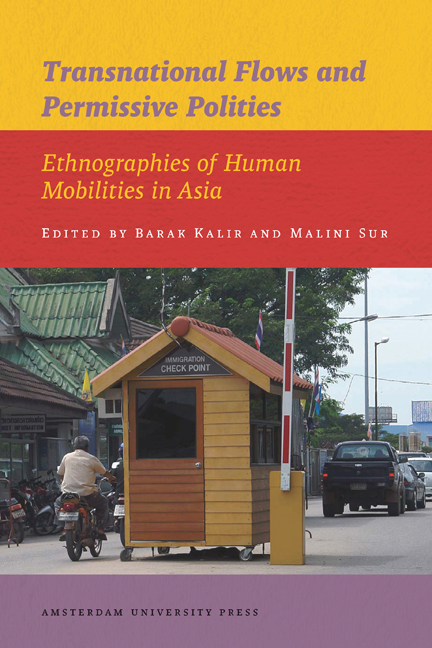Book contents
- Frontmatter
- Contents
- List of Tables, Maps, Figures and Photographs
- Acknowledgements
- Introduction: Mobile Practices and Regimes of Permissiveness
- 1 Illegality Rules: Chinese Migrant Workers Caught up in the Illegal but Licit Operations of Labour Migration Regimes
- 2 Contesting the State of Exception in the Afghan-Pakistani Marchlands
- 3 ‘Looking for a Life’: Rohingya Refugee Migration in the Post-Imperial Age
- 4 Smuggling Cultures in the Indonesia-Singapore Borderlands
- 5 Trade, Transnationalism and Ethnic Infighting: Borders of Authority in Northeast Borneo
- 6 Bamboo Baskets and Barricades: Gendered Landscapes at the India-Bangladesh Border
- 7 Moving between Kerala and Dubai: Women Domestic Workers, State Actors and the Misrecognition of Problems
- 8 Emigration of Female Domestic Workers from Kerala: Gender, State Policy and the Politics of Movement
- 9 Mainland Chinese Migrants in Taiwan, 1895-1945: The Drawbacks of Being Legal
- 10 ‘Playing Edge Ball’: Transnational Migration Brokerage in China
- Epilogue: Irregular Mobilities and Disjunctive Moralities
- About the Editors and Contributors
- Bibliography
- Index
- Publications Series
10 - ‘Playing Edge Ball’: Transnational Migration Brokerage in China
Published online by Cambridge University Press: 15 January 2021
- Frontmatter
- Contents
- List of Tables, Maps, Figures and Photographs
- Acknowledgements
- Introduction: Mobile Practices and Regimes of Permissiveness
- 1 Illegality Rules: Chinese Migrant Workers Caught up in the Illegal but Licit Operations of Labour Migration Regimes
- 2 Contesting the State of Exception in the Afghan-Pakistani Marchlands
- 3 ‘Looking for a Life’: Rohingya Refugee Migration in the Post-Imperial Age
- 4 Smuggling Cultures in the Indonesia-Singapore Borderlands
- 5 Trade, Transnationalism and Ethnic Infighting: Borders of Authority in Northeast Borneo
- 6 Bamboo Baskets and Barricades: Gendered Landscapes at the India-Bangladesh Border
- 7 Moving between Kerala and Dubai: Women Domestic Workers, State Actors and the Misrecognition of Problems
- 8 Emigration of Female Domestic Workers from Kerala: Gender, State Policy and the Politics of Movement
- 9 Mainland Chinese Migrants in Taiwan, 1895-1945: The Drawbacks of Being Legal
- 10 ‘Playing Edge Ball’: Transnational Migration Brokerage in China
- Epilogue: Irregular Mobilities and Disjunctive Moralities
- About the Editors and Contributors
- Bibliography
- Index
- Publications Series
Summary
In Chinese, ‘playing edge ball’ is a popular saying meaning an activity intended to challenge the existing rules and avoid punishment. Originally, ‘edge ball’ was a term used in table tennis. If the on-coming ball hit only the edge of the tabletop, it would be almost impossible for the receiver to return the ball; thus, the player who successfully hit the edge ball would win the point. It is a great challenge to both hit and receive an edge ball. Therefore the term ‘playing edge ball’ is often used to connote people who try to gain profit at the edge of the law or regulation while avoiding punishment. In today's China, the transnational migration mechanism is just like a field where the relevant people play edge ball on purpose.
The current trend for emigration from mainland China to the developed world has attracted the attention of Western scholars. Relevant studies have focused on motivation and social networks as well as criminal trafficking and smuggling (Kwong 1997; Smith 1997; Chin 1999; Skeldon 2000; Nyiri & Saveliev 2002; Liang & Morooka 2004; Pieke, Nyiri, Thuno & Ceccagno 2004). However, little has been written in detail about how the Chinese authorities manage ongoing emigration flows. One paper, written by Biao Xiang, focused on exit control by Chinese authorities (Xiang 2003). Although his general systematic review is enlightening, the author does not detail how illegal labour export agencies are able to function successfully and continually while the Chinese government has been trying to exercise control and strictly regulate these agencies.
This paper focuses on the emergence and development of emigration brokerage and explores the trends of current Chinese emigration from perspectives that are relatively less investigated. My contribution proposes to trace the historical trajectory as well as the function of emigration in weaving migration networks, chronologically. First, it will trace the early emergence of the transnational migrant brokerage from the late Qing Dynasty to the early period of the Republic of China. The contrasting social memories of this group of people will be noted. The second period covers the 1950s to the 1970s as a special model of transnational labour migration under the government's comprehensive umbrella.
- Type
- Chapter
- Information
- Transnational Flows and Permissive PolitiesEthnographies of Human Mobilities in Asia, pp. 207 - 228Publisher: Amsterdam University PressPrint publication year: 2012
- 1
- Cited by

